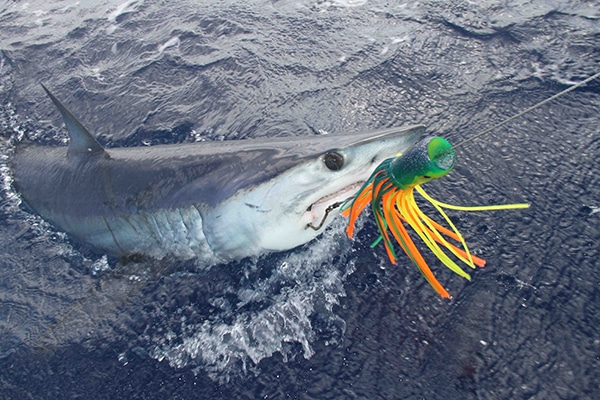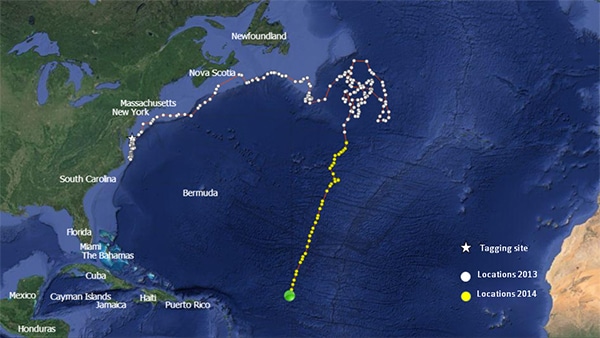
Researchers say a juvenile shortfin mako shark tagged more than eight months ago off Ocean City Maryland is tracking a highly unusual path directly south in the mid-Atlantic – a fast track to a mystery destination.
“I’ve never seen one act quite like this one,” said Dr. Mahmood Shivji, Director of Nova Southeastern University’s (NSU) Guy Harvey Research Institute (GHRI) and Save our Seas Research Center. “The mako is displaying an amazingly directed movement – as if this shark has a specific destination it wants to get to in a hurry,” he added, pointing to a computer screen showing the nearly straight vertical path of a young male mako dubbed I-NSU.
The public can also follow I-NSU as well as other tagged sharks in near real-time, courtesy of an interactive online website set-up by GHRI (www.nova.edu/ocean/ghri/tracking/).

Shivji and his GHRI team have satellite tagged and tracked several species of sharks. I-NSU is among 16 mako sharks tagged with special satellite-linked devices allowing GHRI researchers to monitor their movements. The research team has a particular interest in mako shark behavior and conservation. In addition to being the NSU athletics mascot, this fast swimming species is also under heavy fishing pressure. In fact, three of the nine mako sharks GHRI started tracking in 2013 were captured in commercial longline fisheries.
The tracking website is an educational outreach component of GHRI’s quest to study shark migration patterns, with the ultimate goal being to better understand and protect them, as some species are threatened or endangered.
NSU’s GHRI began tagging mako sharks in 2009 to study their migratory patterns and now undertakes expeditions worldwide to study these amazing animals. The school’s marine experts have tagged mako sharks as far away as Mexico and New Zealand. In addition to makos, GHRI and Save Our Seas Shark Research Center scientists are also tracking tiger, oceanic white tip and sand tiger sharks, as well as blue marlin.
Shivji said tagged sharks, though many do traverse thousands of miles, often move in irregular patterns, sometimes even crossing over previous tracks and frequently changing directions.
“I-NSU also showed an irregular and looping pattern for four months when it was exploring northern latitudes, but at some point it decided it was time to get somewhere directly south and has been on a virtual straight track for the last nearly 1,100 miles,” he said.
Is the shark on a mission to reach a destination?
“I guess we will just have to wait and see,” said Shivji. “It certainly hasn’t been meandering for the past 26 days. It sure looks like it’s focused on getting somewhere specific.”








